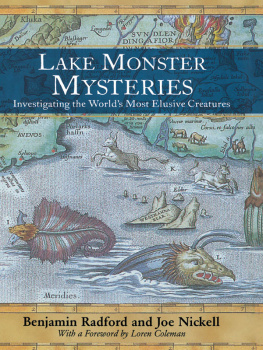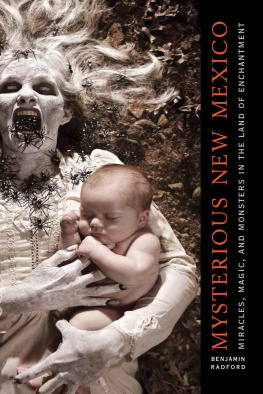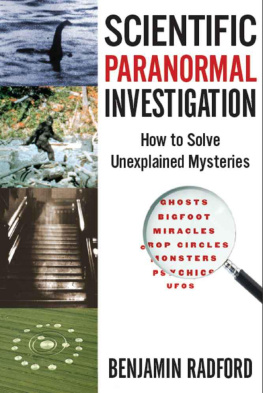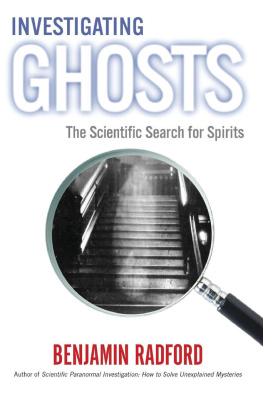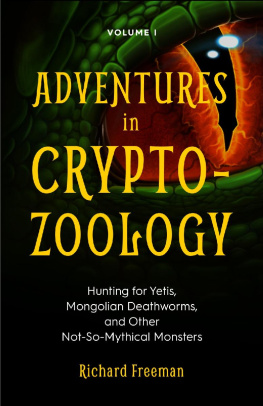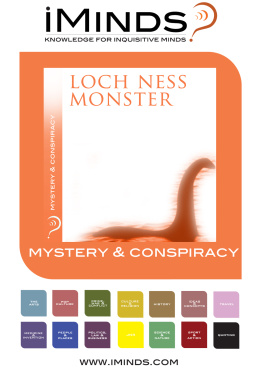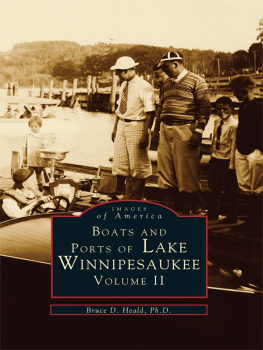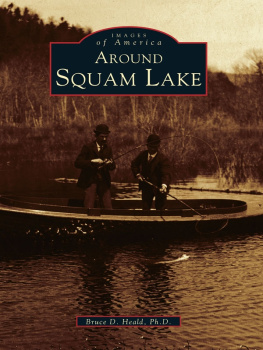Lake Monster
Mysteries
Lake Monster
Mysteries
Investigating the Worlds
Most Elusive Creatures
B ENJAMIN R ADFORD
J OE N ICKELL
Foreword by Loren Coleman
T HE U NIVERSITY P RESS OF K ENTUCKY
Publication of this volume was made possible in part by a grant
from the National Endowment for the Humanities.
Copyright 2006 by The University Press of Kentucky
Scholarly publisher for the Commonwealth,
serving Bellarmine University, Berea College, Centre College of Kentucky,
Eastern Kentucky University, The Filson Historical Society, Georgetown College,
Kentucky Historical Society, Kentucky State University, Morehead State University,
Murray State University, Northern Kentucky University, Transylvania University,
University of Kentucky, University of Louisville, and Western Kentucky University.
All rights reserved.
Editorial and Sales Offices: The University Press of Kentucky
663 South Limestone Street, Lexington, Kentucky 40508-4008
www.kentuckypress.com
10 09 08 07 06 5 4 3 2 1
Some of the material was previously published and is reprinted here courtesy of the Committee for the Scientific Investigation of Claims of the Paranormal. Parts of in the September 2003 Skeptical Briefs newsletter. All other material is new and original.
Library of Congress Cataloging-in-Publication Data
Radford, Benjamin, 1970
Lake monster mysteries : investigating the worlds most elusive
creatures / Benjamin Radford and Joe Nickell.
p. cm.
Includes bibliographical references and index.
ISBN-13: 978-0-8131-2394-3 (hardcover : alk. paper)
ISBN-10: 0-8131-2394-1 (hardcover : alk. paper)
1. Monsters. 2. Lake animals. I. Nickell, Joe. II. Title.
QL89.R33 2006
001.944--dc222005031052
This book is printed on acid-free recycled paper meeting the requirements of the American National Standard for Permanence in Paper for Printed Library Materials.

Manufactured in the United States of America.

To Sir Richard Burton, Johan Reinhard,
Ernest Shackleton, Francisco de Orellana,
Edmund Hillary and Tenzing Norgay,
and the nameless and countless other explorers
whose bravery and thirst for knowledge inspired me.
B. R.
IN MEMORIAM
My parents, J. Wendell and Ella T. Nickell,
who nurtured my inquisitiveness,
and three paranormal investigators
who led the way in conducting hands-on investigations:
magicians Harry Houdini and Milbourne Christopher,
and my late dear friend, psychologist Robert A. Baker.
J. N.
The interests of truth have nothing to
apprehend from the keenness of investigation,
and the utmost severity of human judgment.
Dr. Stubbins Ffirth, pioneering medical investigator, 1804
Contents
Benjamin Radford
Joe Nickell
Joe Nickell and Benjamin Radford
Joe Nickell
Joe Nickell
Benjamin Radford
Joe Nickell
Joe Nickell and Benjamin Radford
Joe Nickell and Benjamin Radford
Joe Nickell
Benjamin Radford
1 Mysteries and Misinformation: How
Cryptozoologists Created a Monster
Foreword
There are always two sides to a story. The book you are about to read is the best version to date of a skeptical look at the entities known as lake monsters. The formal examination of lake monsters has been a subfield of cryptozoological research for more than two centuries. During the fifty years that I have been studying these freshwater cryptids, I have learned much about them.
According to surveys and research that I and other cryptozoologists have conducted, more than a thousand lakes around the world harbor large, unknown animals unrecognized by conventional zoology. Such claims have a long history and a rich representation in the worlds mythology and folklore. The term lake monsters is a relatively recent appellation; traditionally, such creatures have gone by a variety of names, including great serpents, dragons, water horses, worms, and others. They share the landscape with other legendary entities, such as Sasquatch, sea serpents, and black panthers.
Some of the long-ago sightings are remembered in fantastic fashion, which is often what happens when people have real encounters with new animals in new lands. In Water-Monsters of American Aborigines (Journal of American Folklore, 1889), Albert S. Gatschet surveyed stories of peculiar aquatic monsters, including the great horned reptile of the Ohio River region and the horned snake. The Creeks, when they lived in Tennessee, spoke of a large, horned snakelike animal that frequented water holes. The creature could be brought to the shore by the magical singing of Creek elders, and when it showed its horn, the Indians would cut it off. The horn was then taken as a fetish and carried into war, to ensure success in battle.
An account from the Oneida branch of the Tuscaroras, collected by David Cusick and published in 1828, tells of the Mosqueto, which rose from Lake Onondaga (near Syracuse, New York) and slew a number of people. The natives also said that 2, 200 years before the time of Columbus (approximately 700 BC ), a great horned serpent appeared on Lake Ontario and killed onlookers with its overpowering stench.
The strikingly similar horned beast of Alkali Lake (now known as Walgren Lake) near Hay Springs, Nebraska, was the subject of tales by the local Indians. These native Nebraskans told the first white settlers in the area to be on the lookout for the monsters. The legend seems to have had some truth, for more modern sightings followed. The Omaha World-Herald of July 24, 1923, carried the testimony of J. A. Johnson, who stated, I saw the monster myself while with two friends last fall. I could name 40 other people who have also seen the brute. Johnson claimed that the stubby, alligatorlike head had a projection like a horn on it between the eyes and nostrils. The gray-brown creature devoured livestock, uttered a dreadful roar, and smelled horrible. News of Alkali Lakes horned wonder spread around the world.
Michel Meurger and Claude Gagnon underscore the importance of these legends in their book Lake Monster Traditions (1988): From Alaska to New Mexico the belief in a horned serpent-shaped water beast of enormous dimensions is widespread. They go on to place such creatures in a folkloric framework.
Probably the issue of lake monsters would be of concern only to antiquarians were it not for a large body of modern reports from seemingly credible eyewitnesses, most prominently at Loch Ness in Scotland, Lake Champlain in Vermont-New York-Quebec, and Lake Okanagan, British Columbia. In addition, there are unexplained, instrumented observations of large, moving bodies under the waters surface, as well as a small number of intriguing photographs that dont seemat least from my cryptozoologists point of view and examinationto be fraudulent or to depict mundane objects. In other words, the evidence isnt conclusive and probably wont be until incontrovertible physical evidence (a bodyor at least a part of one) is available. Nonetheless, it is suggestive enough to keep the issue very much alive.
The scientific investigation of lake monsters initially occurred in the beginning of the nineteenth century, and it had much to do with the controversy surrounding sea serpents. During those early days, some journalists and theorists assumed that lake monsters were sea serpents that had either temporarily or permanently entered freshwater bodies from the ocean. It was further reasoned that a sea serpent would be more easily captured in an accessible place like a lake or river than in the vast ocean. This, of course, has not proved to be true, but it was hardly an unreasonable conclusion at the time.

